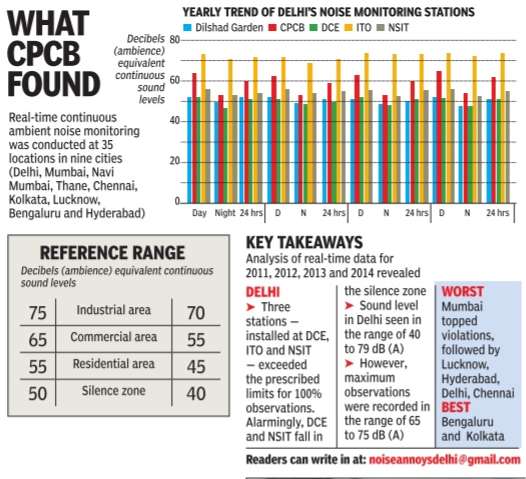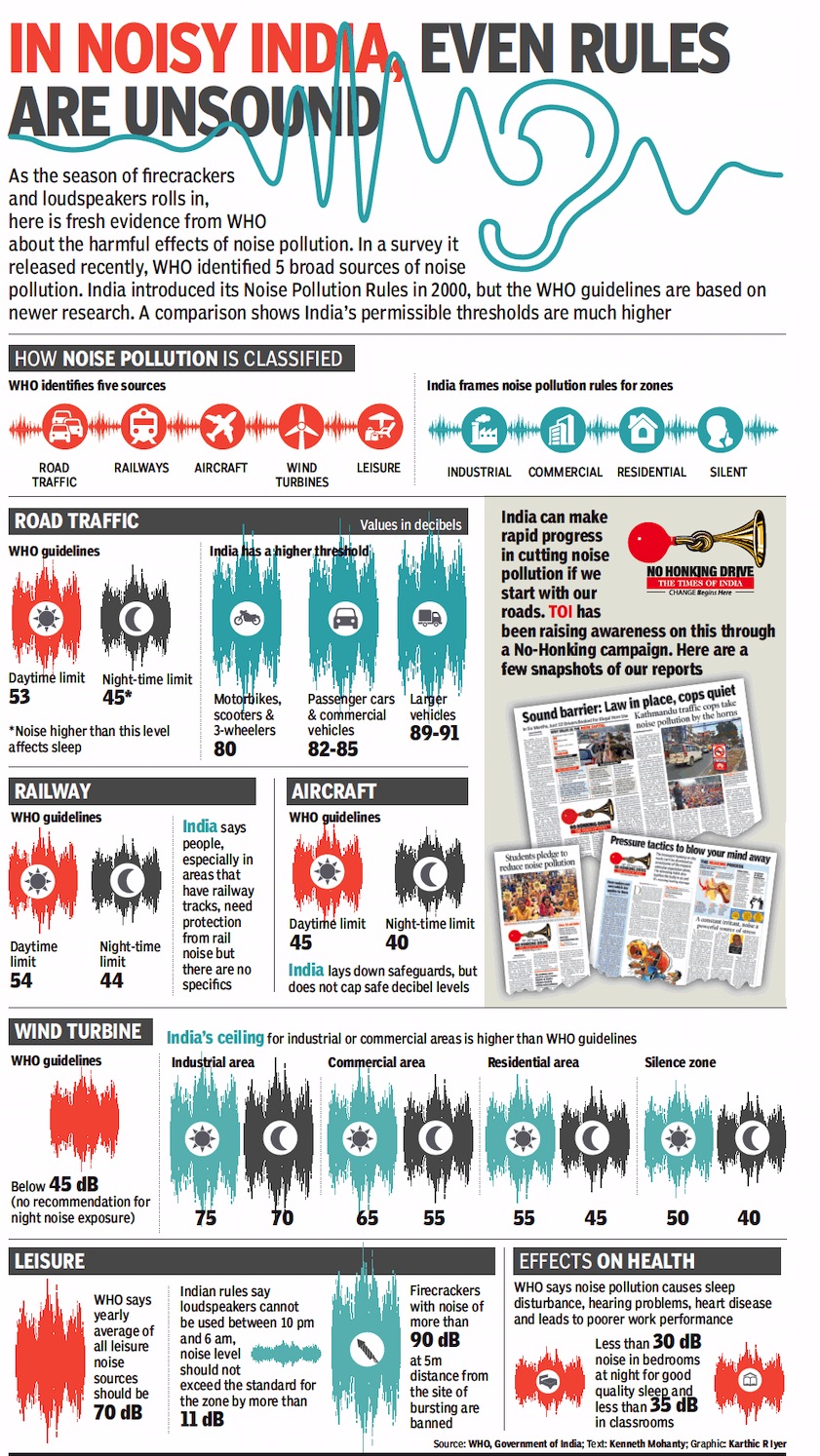Noise Pollution: India
This is a collection of articles archived for the excellence of their content. |
Contents[hide] |
Court/ NGT judgements
A serious punishable crime, Police to take strict action
March 21, 2019: The Times of India
Noise pollution beyond prescribed norms is a serious punishable crime, the National Green Tribunal said and asked Delhi Police to map such hotspots as also put in place a surveillance mechanism for taking strict action against violators.
A bench headed by NGT chairperson Justice Adarsh Kumar Goel directed the police commissioner to monitor the implementing officers in order to safeguard the right of citizens and email the report within a month.
The green court said that citizens have constitutional right to peaceful environment and noise pollution beyond prescribed norms is a serious punishable crime for which adequate preventive and remedial action is needed.
“There has to be strict action of identifying and mapping the hotspots of noise pollution, requiring installation of noise measuring device,” the bench said. “There has to be a surveillance and monitoring mechanism, coordination with the educational institutions and resident welfare associations at regular intervals,” it added while posting the matter for hearing on July 12.
The tribunal said it had an interaction with the concerned officers in an attempt to advise them on understanding their responsibility and accountability to law and their duty to the society. NGT’s observation came while dealing with a plea alleging that illegal use of loudspeakers at mosques was adversely affecting the health of the residents living in their vicinity in east Delhi.
The city-wise position
2022: the world’s noisiest
March 27, 2022: The Times of India

From: March 27, 2022: The Times of India
Moradabad: UP’s Moradabad is the second-most noise polluted city globally, according to the recent ‘Annual Frontier Report, 2022’ published by the United Nations Environment Programme (UNEP). The area recorded noise pollution of an ear-splitting 114 decibels at its highest (dB) in 2021, the report said, reports Akhlad Khan.
The report ranks 61 cities around the world, of which Dhaka tops the list with a noise pollution of 119 dB. Islamabad is third, with maximum noise pollution of 105 dB. Thirteen cities from South Asia feature in the list. Five of them are from India. The other four are Kolkata at 89 dB, Asansol (89 dB), Jaipur (84 dB), and Delhi at 83 dB.
The state-wise position
Delhi
The Times of India, June 9, 2016
Noise pollution is a killer too

The busy ITO junction in Delhi registers around 74 decibel (dB) of sound on a typical day , almost 10db over the limit for commercial areas. The level near Acworth Hospital in Mumbai's Wadala is usually 70dB, almost 20dB more than what's permitted in such a zone.
Noise pollution is now linked to many ailments from irreversible hearing loss to anxiety attacks to hypertension and heart disease. Considering that every 10dB increase makes the sound twice as loud to the human ear, the health implications for a regular commuter are serious. The situation is so bad in cities that ENT specialists now say a 20dB loss in hearing among urbanites is “normal“.
That's the impact of the constant onslaught of noise on our ears, say experts.It's a subject on which there is limited research and little understanding.
“People don't realise that noise is the hidden enemy of man. It affects your en tire body , said Dr Yeshwant Oke, who brought noise pollution into the public consciousness when he filed the first noise pollution-related petition in the Bombay courts in 1985.
Sumaira Abdulali of Awaz Foundation echoes a similar sentiment: “People will adjust to living next to a railway station despite the disturbance caused by loud announcements and honking. Loud music is one of the leading cause of police complaints the world over, including India, but we never think too much about the harm of constant honking by cars on the roads just outside their house. Clearly , the main sources of noise in the main urban centres are vehicles,
Loudspeakers for religion, social events
Triyadan: Silent prayers
Nazar Abbas, Temples and mosques go mute in Rampur, June 4, 2017: The Times of India
In show of communal amity , Hindus agreed to remove loudspeaker from temples and Muslims from mosques in a restive Moradabad village. According to police officials, tension was simmering in the village for the past three years over loudspeakers at temples and mosques.
Circle officer (rural) Chakramani Tripathi said, “Police and district administration of Moradabad are full of praise for the initiative taken by the elders of both the communities who amicably resolved the issue in the holy month of Ramzan.“
Triyadan village under the jurisdiction of Bhagatapur police station here has been in news for recurring communal violence over the use of loudspeakers on places of worship of both the communities .
2018: HC makes UP ban illegal loudspeakers, even at religious places
After receiving flak from the Allahabad high court over noise pollution in Uttar Pradesh, the state government issued detailed directives on Sunday to all district administrations over use of permanently installed loudspeakers at public places.
According to the circular issued to all 75 district magistrates in the state, the local administrations will identify religious structures/places and public areas in their respective districts where unauthorised loudspeakers are being used, and serve notices to the owner/manager/trustee of such places. If they failed to obtain permission for the usage of loudspeakers under the permissible limit then police and local administration have to ensure they are removed by January 20.
The directive is also applicable for loudspeakers being used in public places, marriage processions, protests, parades or similar kind.
The HC had on December 20, 2017 sought to know what action had been taken against such illegal installations and also against the officers who failed to ensure that rules were followed.
HC dismisses plea against ‘no-loudspeaker’ order at 2 UP mosques
Rajesh Kumar Pandey , January 22, 2020: The Times of India
ALLAHABAD: Stating that no religion advocates the use of loudspeakers for worship, the Allahabad high court has declined to quash an administrative order barring the use of loudspeakers for azaan at two mosques in Baddopur and Shahganj villages of UP’s Jaunpur district.
“No religion prescribes or preaches that prayers are required to be performed through voice amplifiers or by beating of drums...If there is such a practice, it should not adversely affect the rights of the others, including that of not being disturbed,” the division bench of Justice Pankaj Mithal and Justice VC Dixit said while dismissing a petition filed by one Masroor Ahmad and a fellow resident of Jaunpur.
A copy of the order, issued on January 9, was uploaded to the high court’s website.
While arriving at its verdict, the division bench harked back to a Supreme Court judgment in a similar case. In the Church of God (Full Gospel) vs KKR Majestic Colony Welfare Association case dating back to 2000, the apex court had said that freedom to practice and profess a religion under Articles 25 and 26 of the Constitution were subject to public order, morality and health. The division bench dismissed the argument of the petitioners that using loudspeakers to call people out to join in the azaan at specific times was an essential part of their religion. “The fundamental right to religious freedom under Article 25 (1) of the Constitution is not an absolute right. It is subject to Article 19(1)(a) (freedom of speech and expression) of the Constitution, and thus both of them have to be read together and construed harmoniously,” the judges said.
The petitioners had submitted an application to the Jaunpur district administration in March last year, seeking permission to use loudspeakers in two mosques at Baddopur and Shahganj. On March 7, the circle officer of Shahganj conducted a spot inspection and stated in his report that the areas in which these two mosques were located had a mixed population of Hindus and Muslims. The report said if any of these communities were allowed to use sound amplifiers, it could trigger friction between them and create a law-and-order problem.
In a notification issued on June 12, the sub-divisional magistrate of Shahganj denied permission/renewal of the licence to use amplifiers and loudspeakers at the two mosques, citing the likelihood of animosity between two religious communities in areas with a mixed population.
Referring to that notification, the division bench said, “It becomes quite evident that the petitioners have been refused permission to use a sound-amplifying system at the mosques, not only for the inherent reason of noise pollution but in order to maintain peace and tranquillity.”
The court also mentioned that public awareness about the adverse effects of noise population was generally low. “People in India do not realise that noise in itself is a sort of pollution. They are not even fully conscious about its ill effects on health, though some concern is being shown to it in the recent past.”
According to a January 2018 order issued by the Yogi Adityanath government, no loudspeaker, public address system, sound-producing instrument or amplifier can be used in a public place without official permission under Rule 5 of the Noise Pollution (Regulation and Control) Rules, 2000.
The Sources of Noise Pollution
Sources and damage caused + Indian rules/ 2018

Indian rules/ 2018
From: October 18, 2018: The Times of India
See graphic:
Noise Pollution and India: The sources and damage caused
Indian rules/ 2018
Delhi: the main sources
2020, 21
Jasjeev Gandhiok, Sep 5, 2021: The Times of India

From: Jasjeev Gandhiok, Sep 5, 2021: The Times of India
The capital recorded 18 noise-pollution violations every day last year, while in the first three months of 2021, 16 violations were recorded each day, states the data submitted by Delhi Police to the National Green Tribunal (NGT).
The police recorded 6,712 such cases last year, while 1,442 violations were registered till March 31 this year. A majority of the violations — 70% or 1047 cases — occurred due to loudspeakers and public announcement systems not adhering to the prescribed noise standards.
The cops also stated that construction equipment were the second biggest source of noise pollution in Delhi, with 273 cases registered so far this year, followed by 99 cases where generator sets were not following noise norms.
The report states while Delhi Police acted on violators, the traffic police also issued fines for noise pollution on roads. The capital recorded a total of 2,883 fines from January 1 till March 31, 2021, out of which 2,070 were f or modified exhausts and silencers. A total of 560 fines were, meanwhile, issued against the use of pressure horns, 224 for playing loud music in vehicles and 29 fines against blowing horns in silent zones.
To register noise-related complaints, Delhi government has set up both a website, as well as a helpline number. While online complaints can be submitted on Ngms.delhi.gov.in, people can also call the helpline number 155271 for noise-related violations.
The Delhi Pollution Control Committee (DPCC) recently notified a new set of fine limits for noise-related violations, which could go up to Rs 1 lakh, if the prescribed noise standards are not adhered to. While the use of loudspeakers or public address systems beyond permissible limits could attract a fine of Rs 10,000, DG sets that are too loud could bring a fine of Rs 10,000 to Rs 1 lakh. Loud construction equipment can meanwhile attract a fine of Rs 50,000, while there is a fine of Rs 1,000 if firecrackers being burst are not adhering to the fixed limits.
A senior DPCC official said they were in the process of compiling data for the rest of 2021, which includes the latest fines. “Once compiled, we will know the biggest sources and whether or not the increase in the fines has reduced the number of cases or not,” said the official.